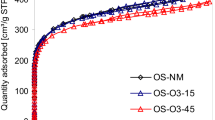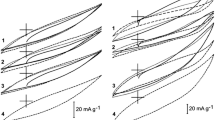Abstract
Commercial activated carbon (Norit R3ex), de-mineralised with conc. HF and HCl, was oxidised (conc. HNO3) and heat-treated at various temperatures (180, 300 and 420 °C). The physicochemical properties of the samples obtained were characterised by selective neutralisation and pH-metric titration of surface functional groups (acid–base properties), thermogravimetry (thermal stability—TG), FTIR spectroscopy (chemical structure) and low-temperature nitrogen adsorption (BET surface area). Thermal treatment of the carbon materials caused the surface functional groups to decompose; in consequence, the chemical properties of the carbon surfaces changed. Cyclic voltammetric studies were carried out on all samples using a powdered activated carbon electrode (PACE) and a carbon paste electrode (CPE), as were electrochemical measurements in aqueous electrolyte solutions (0.1 M HNO3 or NaNO3) in the presence of Cu2+ ions acting as a depolariser. The shapes of the cyclic voltammograms varied according to the form of the electrodes (powder or paste) and to the changes in the surface chemical structure of the carbons. The electrochemical behaviour of the carbons depended on the presence of oxygen-containing surface functional groups. The peak potentials and their charge for the redox reactions of copper ions \( \left( {{\text{Cu}}^{2 + } \leftrightarrow {\text{Cu}}^{ + } \leftrightarrow {\text{Cu}}^{0} } \right) \) depended on their interaction with the carbon surface.







Similar content being viewed by others
References
Bansal RC, Goyal M (2005) Activated carbon adsorption. CRC/Taylor and Francis Group, Boca Raton
Radovic LR, Moreno-Castilla C, Rivera-Utrilla J (2001) In: Radovic LR (ed) Chemistry & physics of carbon, vol 27. Marcel Dekker, Inc, New York, p 227
Biniak S, Świątkowski A, Pakuła M (2001) In: Radovic LR (ed) Chemistry & physics of carbon, vol 27. Marcel Dekker, Inc, New York, p 125
Kinoshita K (1988) Carbon: electrochemical and physicochemical properties. Wiley, New York
Hsieh CT, Teng H (2002) Carbon 40:667
Pakula M, Biniak S, Swiatkowski A, Neffe S (2002) Carbon 40:1873
Beilby AL, Carlsson A (1988) J Electroanal Chem 448:283
Surya A, Murthy NA (1993) Electroanalysis 5:265
Yang Y, Lin ZG (1994) J Electroanal Chem 364:2
Shin H, Park M, Kim AR, Kang C (2003) J Electroanal Chem 547:143
Drissi-Daoudi R, Irhzo A, Darchen A (2003) J Appl Electrochem 33:339
Cofre P, Bustos A (1994) J Appl Electrochem 24:564
Jannakoudakis AD, Jannakoudakis PB, Theodoridou E, Besenhard JO (1990) J Appl Electrochem 20:619
Kalcher K, Kauffmann JM, Wang J, Svancara I, Vytras K, Neuhold C, Yang Z (1995) Electroanalysis 7:5
Darlewski W, Swiatkowski A (1997) Przemysł Chemiczny 76:440 (in Polish)
Lopes da Silva WT, Thobie-Gautier C, Rezende MOO, El Murr N (2002) Electroanalysis 14:71
Pakula M, Swiatkowski A, Biniak S (1995) J Appl Electrochem 25:1038
Shiu KK, Shi K (1998) Electroanalysis 10:959
Dandekar A, Baker RTK, Vannice MA (1999) J Catal 183:131
Pletcher D, Sheridan AJ (1998) Electrochim Acta 43:3105
Jannakoudakis AD, Jannakoudakis PB, Pagalos N, Theodoridou E (1994) Electrochim Acta 39:1881
Garjonyte R, Malinauskas A (1998) Sens Actuators B Chem 46:236
Jankowska H, Świątkowski A, Choma J (1991) Active carbon. Ellis Horwood, New York
McCreery RL, Cline KK (1996) In: Kissinger PT, Heineman WR (eds) Laboratory technique in electroanalytical chemistry, 2nd edn. Marcel Dekker, New York
Guaus E, Torrent-Burgues J (2007) Portugaliae Electrochim Acta 25:139
Driad JP, Montella C (2006) J Electroanal Chem 590:126
Bond AM (1980) Modern polarographic methods in analytical chemistry. Marcel Dekker, New York
Biniak S, Pakuła M, Szamański GS, Świątkowski A (1999) Langmuir 15:6117
Acknowledgements
This work was partly supported by the Polish Ministry of Science and Higher Education (project No. 3 T09B 067 29).
Author information
Authors and Affiliations
Corresponding author
Rights and permissions
About this article
Cite this article
Biniak, S., Pakuła, M., Darlewski, W. et al. Powdered activated carbon and carbon paste electrodes: comparison of electrochemical behaviour. J Appl Electrochem 39, 593–600 (2009). https://doi.org/10.1007/s10800-008-9697-x
Received:
Accepted:
Published:
Issue Date:
DOI: https://doi.org/10.1007/s10800-008-9697-x




